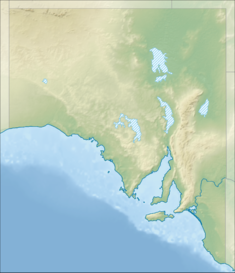Barossa Reservoir
| Barossa Reservoir | |
|---|---|
 The reservoir from its arch dam | |
| Country | Australia |
| Location | Williamstown, South Australia[1] |
| Coordinates | 34°39′00″S 138°50′56″E / 34.650°S 138.849°E |
| Purpose | water supply |
| Construction began | 1899 |
| Opening date | 1902 |
| Built by | Engineering and Water Supply Department |
| Owner(s) | SA Water |
| Dam and spillways | |
| Type of dam | Arch dam |
| Impounds | Yettie Creek |
| Height | 36 metres (118 ft) |
| Length | 144 metres (472 ft) |
| Reservoir | |
| Total capacity | 4,515 megalitres (159.4×106 cu ft) |
| Surface area | 0.62 km2 (0.24 sq mi) |
| Website http://www.sawater.com.au/community-and-environment/our-water-and-sewerage-systems/water-sources/reservoir-data/barossa-reservoir | |
Barossa Reservoir is a reservoir in the Australian state of South Australia, built between 1899 and 1902 to supply water to Gawler and other northern country areas. Built at a cost of almost A£170,000 the reservoir was hailed on completion as an engineering marvel, and with the reservoir wall rising to a height of 36 metres (118 ft), it was, at the time of its completion, the highest dam wall in Australia.[2]
Location and features
[edit]The thin arch of the dam retaining wall, curved against the pressure of the water, was an innovation considered radical, and attracted the Reservoir international attention.[3] It was featured in the Scientific American and caused the American Engineers News to remark that its "boldness of design deserves to rank with the most famous dams in the world".[3] The dam is notable for its parabola effect, where a voice can be heard clearly from one side to the other – over 140 metres (460 ft), end to end. This unusual acoustic phenomenon is a popular tourist attraction, and has earned the dam the title "Whispering Wall" (see Whispering gallery).[4]
During construction large stones were used in the wall to save concrete and tram rails were used to reinforce the upper section.[5] The Barossa Reservoir was formed by damming the Yettie Creek gorge in the northern Mount Lofty Ranges, a feat that took over 400 men.[2] Its water comes through a two-kilometre (one-mile) tunnel, carved by horse power, from the South Para River and Reservoir, and is supplemented by the Warren Reservoir and the River Murray. In addition to Gawler and country, a filtration plant constructed in 1982[6] allows the Reservoir to supply the suburbs of Munno Para and Elizabeth.[citation needed]
The dam's vegetated surrounds are also protected. Aside from its acoustic attraction, the Whispering Wall offers great views of both the Barossa Reservoir and the surrounding, well-preserved natural bounty. The area abounds in thick scrub, tall red gums, and pines, and a flourishing bird and animal life. It is a popular destination for picnics and bird-watching.[citation needed]
In 2008, its engineering heritage was recognised by the installation of a marker provided by the Engineers Australia's Engineering Heritage Recognition Program.[7]
Key statistics
[edit]- Capacity: 4,515 megalitres (159.4×106 cu ft)
- Length of wall: 144 metres (472 ft)
- Height of wall: 36 metres (118 ft)
- Depth at wall: 28.6 metres (94 ft)
- Type of wall: Concrete arch
Incidents
[edit]At approximately 4:30 PM on Wednesday 21 April 2021, Henry Shepherdson jumped from the wall with his 9-month-old daughter, Kobi, strapped to him, amongst disturbed onlookers. The father was pronounced dead upon arrival of paramedics and the child later died at the scene. The incident was deemed a murder-suicide as there were witnesses who testify that Henry jumped as opposed to falling. There was a history of domestic violence between Kobi's mother and father.[8][9][10] As of Friday 22 November 2024, A coronial inquest continues [11]
Gallery
[edit]-
The Whispering Wall carries sounds clearly over 140 metres (460 ft)
-
Barossa Reservoir from the air
See also
[edit]References
[edit]- ^ "Search result for "Barossa Reservoir (Reservoir) " (SA0004781) with the following layers selected – "Suburbs and Localities" and " Place names (gazetteer)"". Property Location Browser. Government of South Australia. Archived from the original on 12 October 2016. Retrieved 19 June 2016.
- ^ a b "Barossa Reservoir" (PDF). SA Water. c. 2012. Archived from the original on 9 September 2005. Retrieved 16 June 2014.
- ^ a b Conlon, Keith. "Barossa Valley: Whispering Wall". Postcards. Nine Network. Archived from the original on 18 October 2005. Retrieved 30 September 2005.
- ^ "SA Water Reserves: Barossa". South Australian Department for Environment and Heritage. 21 March 2005. Archived from the original on 17 September 2006. Retrieved 30 September 2005.
- ^ "Barossa Reservoir" (PDF).
- ^ "Filtration". SA Water, Government of South Australia. Retrieved 23 August 2012.
- ^ "Barossa Dam, South Para River, 1903-". Engineering Heritage Recognition Program. Engineers Australia. Retrieved 19 June 2016.
- ^ "Baby who died in tourist spot 'murder-suicide' with dad identified". 22 April 2021.
- ^ "Reference at www.theaustralian.com.au".
- ^ Police, South Australia. "Front Page News". South Australia Police – Keeping SA Safe. Retrieved 3 June 2021.
- ^ "Baby Kobi's father mentioned Whispering Wall in phone conversation a month before murder-suicide". 22 November 2024.



